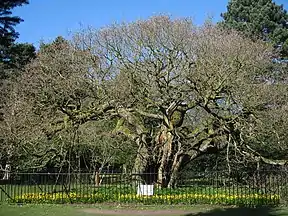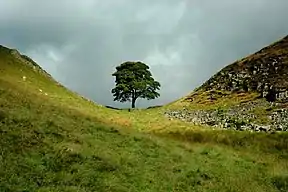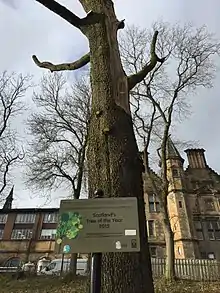Tree of the Year (United Kingdom)
The Tree of the Year competition is held in the United Kingdom in Autumn each year by the Woodland Trust, a nationwide conservation charity. Nominated trees are shortlisted by a panel of experts before going to public votes to select a tree of the year for each of the four constituent countries of the United Kingdom. The panel then selects one of these to become Britain's tree of the year and be nominated for the following year's European Tree of the Year. The competition has been run each year since 2014.
.png.webp)

.jpg.webp)
.jpg.webp)



History
The European Tree of the Year competition has been running since 2011 and selects a tree from participating countries (now 13 in number) by public vote. It was inspired by an earlier Czech national contest. Most countries hold a national poll to select their entrant for each year.[1] Nominations are made in the year preceding the award. The United Kingdom did not enter the competition until 2013 when Niel Gow's Oak and the Oak at the Gate of the Dead were nominated for Scotland and Wales respectively for entry into the 2014 award. These trees finished seventh and ninth out of the 10 entries for that year.[2] The following year the Woodland Trust, a nationwide conservation charity, took responsibility for nominating British entries into the competition. It instigated national competitions in England, Wales and Scotland.[3] The winners of this competition were entered into the European Tree of the Year awards for 2015.[4] In 2015, the British awards were widened to include Northern Ireland.[5] The Woodland Trust altered the format in 2016, introducing an additional round of voting to name a single tree of the year for the whole country. All four national winners were still entered into the European competition.[6] From 2017, only the overall British winner is entered into the European Tree of the Year awards.[7]
Format
The four national competitions are run in September and October and ranking is determined by public vote on the Woodland Trust website. Nominations can be made by any individual or organisation by early August and a shortlist is compiled by a panel of independent experts to put forward to the public vote. Each national winner receives a £1000 grant from the People's Postcode Lottery to be used for any purpose in relation to the tree – this could range from a survey or health check, remedial works, plaques and signs or a celebratory event.[3] A selection of the shortlisted trees will also receive grants of £500.[6][8] Following the public vote one of the four trees will be selected by a panel of experts to become Britain's Tree of the Year and be nominated as the British entry into the European awards, voting for which runs through January and February of the following year.[8][9] In 2018 the Woodland Trust switched format such that the overall British winner was decided by a public vote co-ordinated with the BBC's The One Show.[8] In 2019 the competition reverted to a panel of judges to select the overall British entrant, though the title "Britain's Tree of the Year" was not used.[10]
Results
Britain's Tree of the Year
- 2016 Brimmon Oak[6]
- 2017 Gilwell Oak[11]
- 2018 Nellie's Tree[8]
- 2019 Allerton Oak[10]
- 2020 Survivor Tree[12]
England's Tree of the Year
- 2014 Major Oak[13]
- 2015 Cubbington Pear Tree[14]
- 2016 Sycamore Gap Tree[6]
- 2017 Gilwell Oak[11]
- 2018 Nellie's Tree[8]
- 2019 Allerton Oak[10]
- 2020 Happy Man Tree[12]
Scotland's Tree of the Year
Wales' Tree of the Year
- 2013 Oak at the Gate of the Dead[2][nb 1]
- 2014 Lonely Tree[17]
- 2015 Llanarthne Oak[18]
- 2016 Brimmon Oak[6]
- 2017 Hollow Tree, Neath Port Talbot[11]
- 2018 Pwllpriddog Oak[8]
- 2019 Old Sweet Chestnut, Pontypool Park[10]
- 2020 Chapter House Tree[12]
Northern Ireland's Tree of the Year
- 2015 Woodvale Park Peace Tree[5]
- 2016 Holm Oak, Kilbroney Park, Rostrevor ("Old Homer")[6]
- 2017 Erskine House Tree[11]
- 2018 Multi-stemmed Giant Sequoia, Castlewellan[8]
- 2019 Invisible Tree[10]
- 2020 - competition not run, Woodland Trust team in this region instead celebrated the 20th anniversary of their Woods on Your Doorstep scheme.[12]
Notes
- The UK Tree of the Year competition was not established until late 2014 but in 2013 individual trees in Scotland and Wales were entered into the 2014 European competition. Subsequent entries into the European competition have been granted only to the individual national winners for 2014–2016 and to the overall British winner from 2017.
References
- "About the contest". European Tree of the Year. Retrieved 30 September 2018.
- "European Tree of the Year 2014". Retrieved 30 September 2018.
- Stephenson, Natalie (19 June 2018). "Help us find the nation's Tree of the Year 2018". Woodland Trust. Retrieved 30 September 2018.
- "European Tree of the Year 2015". Retrieved 30 September 2018.
- Smith, Ryan (9 November 2015). "Game of Thrones loses out as this North Belfast tree is named Northern Ireland 'Tree of the Year'". Belfast Live. Retrieved 30 September 2018.
- Hickman, Chris (18 December 2016). "Our Tree of the Year winners are revealed on Channel 4". Woodland Trust. Retrieved 30 September 2018.
- "Who are the winners?". European Tree of the Year. Retrieved 30 September 2018.
- "Tree of Year 2018". Woodland Trust. Retrieved 30 September 2018.
- "European Tree of the Year 2018 – Where is it rooted?". EUROPARC Federation. 14 February 2018. Retrieved 30 September 2018.
- "Tree of the Year 2019". Woodland Trust. Retrieved 26 October 2019.
- "Britain's Tree of the Year for 2017 unveiled". Countryfile. 5 December 2017. Retrieved 30 September 2018.
- "Tree of the Year 2020". Woodland Trust. Retrieved 28 December 2020.
- Barkham, Patrick (14 November 2014). "Major oak in Sherwood Forest voted England's tree of the year". The Guardian. Retrieved 30 September 2018.
- "England's Tree of the Year, Cubbington pear, to be cut down for HS2". The Telegraph. 9 November 2015. Retrieved 30 September 2018.
- "Scottish Tree of the Year crowned". BBC News. 30 October 2014. Retrieved 30 September 2018.
- Gillett, Karrie (28 October 2015). "Century-old Glasgow oak tree hailed as Scottish 'tree of the year'". Scotland Now. Retrieved 30 September 2018.
- "Fallen pine is Wales' tree of year". BBC News. 23 November 2014. Retrieved 30 September 2018.
- "Saved oak wins Tree of the Year award". BBC News. 9 November 2015. Retrieved 30 September 2018.